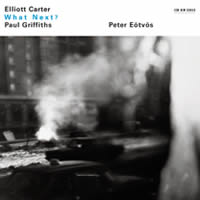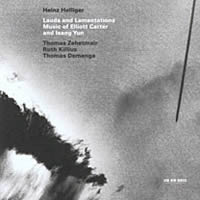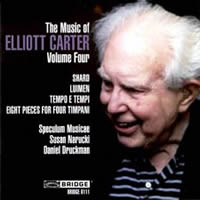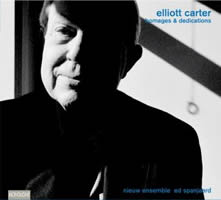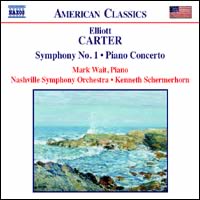RetraCE We NeW E CarteR
|
Grant Chu Covell [May 2004.] America’s foremost contemporary composer, Elliott Carter, will be 96 in December 2004. Although he continues to produce music at a remarkable pace, his is hardly a household name due largely to an unapologetically dissonant (but never serial), arrhythmic style. “All-interval chords” and “metric modulation” are two technical terms that surface in Carter analyses. You don’t need to know what they mean to enjoy his music. Just know that Carter offers heightened intellectual rigor and integrity rare on these shores, and that his music has attracted the best and brightest performers. It’s hard to imagine a La Folia reader unfamiliar with Carter. But just in case you are, what’s the best way to approach his music? Other than playing some yourself, the best thing to do is to pick a piece and listen repeatedly. The breakthrough First String Quartet (1950-51), with motifs that develop at different speeds, is an excellent candidate. Take the classic recording with the Composers Quartet on Nonesuch H-71249, or newer readings with the Arditti Quartet (Etcetera CD KTC 1065) or Juilliard Quartet (Sony Classical 2-S2K47229). Sometimes a Carter piece won’t open up until you notice its humor, a sly twinkle in the eye. Good performances help immensely. A fresh bundle of releases offers excellent vantage points. Old hands should try either the ECM collection or David Starobin breezing through Shard on Bridge. Newcomers can start with the Naxos disc.
Elliott CARTER: What Next? (1997); Asko Concerto (2000). Netherlands Radio Chamber Orchestra, Peter Eötvös (cond.). ECM New Series 1817 (http://www.ecmrecords.com/). Also distributed in the US by iclassics.com (http://www.iclassics.com/). Carter takes the prize for oldest-composer-to-write-his-first-opera. What Next? is a concise (forty-minute), one-act drama to Paul Griffiths’ words. The plot is simple. There’s been a car accident and several stunned people are trying to figure out who they are and what they’re supposed to be doing. The modern setting brims with references to astronomy, surveillance and Zen (also a character’s name). Formally, there’s no exposition. Audience and singers attempt to comprehend events and their implications as the opera progresses. The percussion opening might surprise longtime Carter fans. I recall a silly Candid Camera skit that involved cars crashing in a parking garage. The voices waft in directly after and then we’re off. Carter has a long history of setting text, and he’s completely at home structuring the necessary dramatic ebb and flow. Librettist Griffiths is one of contemporary music’s great chroniclers. A prescient Carter elucidator, Griffiths has supplied the ideal text, dense with multiple themes and recurring ideas. The booklet offers the diary Griffiths kept as the project came into being. The music is hardly simple, but rare to contemporary nontonal opera, the words are in English and immediately comprehensible. The glittering orchestral textures have Schoenberg’s expressive force, though Carter crafts with a more fluid touch. The ensemble cast of soloists (Valdine Anderson, Sarah Leonard, sopranos; Hilary Summers, contralto; William Joyner, tenor; Dean Elzinga, baritone; Emanuel Hoogeveen, boy alto) finds its way with subtle orchestra support, as if What Next? were actually chamber music or a madrigal collection. Teeming with positive energy, the opera exudes a playful spirit, quite as if nonagenarian Carter knows no angst, anguish or despair. It’s an excellent addition to the genre and a luminescent feather in Carter’s crowded cap. Written directly after the opera, the 16-player, 12-minute Asko Concerto is a spirited little thing, commissioned by the ASKO Ensemble, long associated with the composer. Several groups (a single bassoon, trumpet with violin, bass clarinet, trombone and cello, etc.) take turns under the spotlight only to be interrupted by knife-like chords from the remaining players. Bright like the recent Luimen, but more liquid as instruments coalesce to take concerto-like solos. Carter writes showy and expressive lines, expertly supported by rich textures and harmonies. Peter Eötvös leads the Netherlands Radio Chamber Orchestra.
Elliott CARTER: Oboe Quartet (2001); 4 Lauds: Statement — Remembering Aaron (1999), Riconoscenza per Goffredo Petrassi (1984), Rhapsodic Musings (2000), Fantasy — Remembering Roger (1999); A 6 Letter Letter for English horn (1996); Figment (1994); Figment II — Remembering Mr. Ives (2001). Isang YUN: Piri (1971); Quartet for Oboe and String Trio (1994). ECM New Series 1848/49 (http://www.ecmrecords.com/). Also distributed in the US by iclassics.com (http://www.iclassics.com/). Celebrated oboist Heinz Holliger — no slouch at composition, either — oversaw this double-CD set of Carter and Isang Yun. The set opens with a fantastic performance of Carter’s Oboe Quartet, a clear masterpiece. Holliger, Thomas Zehetmair (violin), Ruth Killius (viola) and Thomas Demenga (cello), the quartet which premiered it, perform with gusto. Ives’ comment about a string quartet representing four men arguing comes immediately to mind. The quartet operates as soloists, not as a string trio accommodating an oboe as in Mozart’s classic. Zehetmair adds steam to 4 Lauds, a collection of short violin solos. Three receive first performances alongside recital staple Riconoscenza per Goffredo Petrassi. Irvine Arditti on his Montaigne solo disc (MO 789003) captures the trifle’s spirit but plays fast and loose with Carter’s explicit rhythms. Maryvonne Le Dizes-Richard finesses the piece’s multiple personalities (New World Records 80333-2), while Rolf Schulte (Bridge BCD 9044) is the most romantic but slowest (6:30, while the others are in the 4:30 neighborhood). Demenga friskily tackles the two Figments. The first, dedicated to him (the second to Fred Sherry), is more vigorous than Roham de Saram’s efficient assail on Montaigne MO 782122 (with the Fifth String Quartet, Fragment for string quartet, Cello Sonata, Duo for violin and piano, and 90+). Sherry presents both Figments on Bridge 9128 (see below). Holliger takes up English horn to play a piece for Paul Sacher. One of the last century’s great music commissioners, Sacher’s requests reached all the way back to Bartók. Yun’s music receives long-overdue star treatment. Holliger compresses the 15-minute oboe solo Piri into an ethereal miniature. (Clarinetist Eduard Brunner offers his contrasting labors on ECM 1599.) All four musicians reunite in an assured performance of Yun’s Oboe Quartet, one of the Korean’s final compositions. With forlorn, swooping glissandi, the slow central movement unveils an especially bleak place, contrasting with the bubbly outer movements. I single this disc out as the best entry point for Yun. Carter’s Oboe Quartet makes it a must.
“The Music of Elliott Carter, Volume 4.” Elliott CARTER: Shard (1997); Luimen (1997); Tempo e Tempi (1999); Eight Pieces for Four Timpani (1950/1966). David Starobin (guit.); Speculum Musicae, William Purvis (cond.); Susan Narucki (sop.); Daniel Druckman (timpani). Bridge 9111 (http://www.bridgerecords.com/). “The Music of Elliott Carter, Volume 5.” Elliott CARTER: Steep Steps (2001); Two Diversions (1999); Oboe Quartet (2001); Figment II — Remembering Mr. Ives (2001); Au Quai (2002); Of Challenge and Love (1994); Figment (1994); Retrouvailles (2000); Hiyoku (2001). Bridge 9128 (http://www.bridgerecords.com/). Bridge’s Carter releases are among the best around, presenting superb performances from players who have worked with Carter over the years. The fourth installment opens with an exciting performance of Shard, a potent guitar miniature, dispatched with panache by its dedicatee David Starobin. Get this disc just to hear Starobin play Shard. It’s commanding, lively and spectacular playing. (A plea to Bridge: Please, oh, please, get David and a friend to tackle Lachenmann’s Salut für Caudwell.) Luimen and Shard constitute a unique pair in Carter’s output. The entire solo guitar piece is present within Luimen’s unlikely coalition of mandolin, guitar, harp, vibraphone, trumpet and trombone. I’m too entranced by Speculum Musicae’s invigorating reading to pinpoint precisely when Shard appears inside Luimen. It’s a sprightly work, sounding like it originates from the 20th century’s start rather than its end. Luimen was written for the Nieuw Ensemble, whose average sonics on Naïve MO 782089 (see below) boldly prove that the folks at Bridge know how to record plucked instruments, perfectly balancing Luimen’s harp, mandolin and guitar against the brass. Tempo e Tempi is an effervescent eight-movement song cycle. Susan Narucki, supported with oboe, clarinet, violin and cello, pays attention to the soaring vocal lines. The earliest work here, Eight Pieces for Four Timpani, in which Carter creates an eloquent expression of his rhythmic concerns for four pitched drums, occupies the longest expanse. One piece, Canaries, appears in a well-known theory book because it clearly illustrates Carter’s approach to multiple melodic ideas moving along at different speeds. Daniel Druckman, son of composer Jacob, plays the eight pieces. Packed with nine works written between 1994 and 2002, Bridge’s fifth volume is a disc to be sampled rather than taken in a headlong plunge. Consider it a sturdily bound reference tome you might consult infrequently but can be guaranteed of its pronouncements. Several pieces are short trifles: Hiyoku for clarinet duo, Steep Steps for bass clarinet, and Au Quai for the near-to-absurd pairing of bassoon and viola. But then this is Carter. His sure hand guides where others would fear to enter. Though duo clarinet recitals are rare, the sprightly Hiyoku would make a great encore piece. Au Quai derives humor from Schoenberg’s mock-etymology for the affirmative Americanism “O.K.” (The expression’s true origins are open to dispute.) Charles Rosen rolls up his sleeves to expand upon his once-complete set of piano music (Bridge 9090: 90+, Sonata and Night Fantasies) with Two Diversions and Retrouvailles. Shading the Two Diversions with a great understanding of Carter’s musical concerns, Rosen reins them close to Schoenberg’s Op. 33 pair. Very evident in the opening accelerating phrase of the second Diversion, Rosen’s pedaling blurs more than Ursula Oppens’ in the Carnegie Hall Millennium Piano Book, sheet music that comes with a CD or a CD that comes with sheet music, depending whether you’re sitting on a piano bench or easy chair. At less than two minutes, Retrouvailles sparkles. The grandest offering, Of Challenge and Love, receives a carefully thought-out interpretation from soprano Tony Arnold and pianist Jacob Greenberg. This song cycle demands repeated listening to savor Carter’s sensitive word painting. (Full disclosure: Ages ago Arnold premiered a composition of mine.) Played by Speculum Musicae, the Oboe Quartet bursts out at a faster clip than ECM’s version (ECM 1848/49, see above), sacrificing clarity and dynamic subtlety for feistiness. Cellist Fred Sherry offers both Figments slightly less passionately than Demenga, but with a more appropriate intimate, conversational character. Repeated listenings and CD swaps made it seem I was auditioning four pieces, not two pairs.
“Homages and Dedications.” Elliott CARTER: Luimen (1997); Scrivo in vento (1991); Con leggerezza pensosa (1990); Changes (1983); Esprit rude / esprit doux II (1994); Bariolage (1992); Inner Song (1992); Immer Neu (1992); Gra (1993); Enchanted preludes (1988); 90+ (1994); Canon for 4 (1984). Nieuw Ensemble. Naïve MO 782089 (http://www.naiveclassique.com/). Distributed in the US by Naxos (http://www.naxos.com/). Compared to Bridge’s Carter items, this disc’s riches require persistence to excavate — a complete surprise to me, considering the label’s catalog and reputation. The best performances are the trio and quartet pieces. Esprit rude / esprit doux II, one of several birthday pieces for Boulez, picks up where an earlier flute and clarinet duet left off but adds marimba. Carter’s clever Canon for 4 bristles with exuberance. Flute, bass clarinet, violin and cello traverse the same line, simultaneously presented forwards, backwards, upside-down and upside-down and backwards. The middle point where everything reverses is magical. Luimen receives a cool performance from the Nieuw Ensemble, the team it was written for. (They also got to name the work.) A 1992 trilogy dedicated to Holliger and his wife, harpist Ursula, are played by Ernest Rombout and Ernestine Stoop. Each shines in a solo in which the other interjects a few notes, and they combine for Immer Neu. Other solo pieces, such as the flute solo Scrivo in vento, are frailer than can be found in the second volume of Bridge’s series (Bridge BCD 9044).
Elliott CARTER: Holiday Overture (1944/61); Symphony No. 1 (1942/54); Piano Concerto (1964-65). Mark Wait (piano); Nashville Symphony Orchestra, Kenneth Schermerhorn (cond.). Naxos 8.559151 (http://www.naxos.com/). Naxos collects fresh performances of three early Carter orchestral works, providing high points in Carter’s stylistic evolution. Stravinsky’s Op. 1, an E-flat symphony overseen by Rimsky Korsakov, doesn’t forecast the cosmopolitan Russian émigré’s future. Richard Strauss’ teenage D minor and F minor symphonies don’t presage the tone poems or operas. Similarly, Carter’s Symphony No. 1 barely hints at later complexity and dissonance. While Strauss’ and Stravinsky’s early symphonies are juvenile works, Carter was in his thirties when he completed his First, firmly grounded in the predominantly tonal American symphonic tradition. Key models were orchestral works of the favorite symphonists of the day, Roy Harris, Copland and Sessions, whose 1933 First Symphony he had copied by hand in order to study. Carter’s 1940s language is definitely more angular than Copland’s or Harris’, but less astringent than Sessions’. The three-movement First was Carter’s attempt to find an approachable vernacular, though his rhythmic preoccupations thicken his argument. There’s nothing neoclassical here. Frequently charged with strong accents, the first movement walks a confident line alternating between two meters. To my surprise, I hear similarities with Nielsen and Robert Simpson in the orchestration, strong on warm brass especially in the frontier-like second movement which grandly crests and ebbs. Carter’s frustrated counterpoint and tangled harmonies might suggest his personal acquaintance with Ives. The folksy final movement plays at lowering and raising the triad’s third, its elaborate coda threatening to immolate the rondo form and any harmonic expectations. The Holiday Overture was written in response to the Allied liberation of France at the safe distance of Fire Island, NY, where the Carters hosted a visit from Aaron Copland. Intended for a first performance under Koussevitzky, Carter had to spirit away the parts from the Boston Symphony Orchestra’s library for a 1945 Frankfurt premiere under Celibidache. The ten-minute work could be mistaken for one of Copland’s populist efforts, with its swaggering tonality and stacked fourths. (Appalachian Spring was also completed in 1944.) Charming and likable, perhaps it will find its way into commercials, as has Copland’s Rodeo. Carter’s future beckons: reckless rhythmic changes, simultaneous themes in different meters, and chords built from the pitches of themes. But would we pay attention to these works if Carter hadn’t taken the path he did? Would he have gone down in history as yet another “nice,” mid-century composer? Probably not. “Nice” neo-Romantics like Argento, Barber, Diamond and Schuman seem to be coming into their own, edging out dissonant masters such as Babbitt, Kirchner and Sessions. Carter’s Piano Concerto, written 20 years after his first symphony, comes from a different planet. Piano and orchestra are combatants in two movements of heightened drama composed in an aggressive atonal but not serial style with ravishingly dense virtuosic flourishes. Uninterested in serialism and neoclassicism, possibly Carter also sought distance from the faux-jazz of Copland’s 1926 concerto. (Unbelievably, the concerto is dedicated to Stravinsky.) A small concertante group (flute, English horn, bass clarinet, violin, viola, cello and bass) shadows the piano as ineffectual intercessor despite solo gestures in the second movement. All the players take their material from 12 distinct pitch collections which change according to a precisely defined large-scale rhythmic structure. At one point the orchestra consists of more than 70 independently moving lines. (An often-reproduced photo shows Carter standing before the imposing page 54.) Written in mid-’60s Berlin within earshot of a shooting range, several passages of repeated notes mimic machine-gun fire, Germany’s postwar history having been a cited influence. Such potent outbursts are commonplace in this exciting, confrontational music. Mark Wait easily navigates the solo piano’s difficulties, and the Nashville Symphony Orchestra under Kenneth Schermerhorn sounds fully committed and experienced. I put this on a par with Ursula Oppens’ recording with the SWF Symphony under Michael Gielen (Arte Nova 74321 27773 2, with the Concerto for Orchestra and a set of fanfares grouped as Three Occasions) or even her older but more fidgety 1984 performance on New World Records NW 347-2 (led again by Gielen, but with the Cincinnati Symphony Orchestra also offering the Variations for Orchestra). There is so much going on, so many captivating passages, that repeated listening is essential. Some listeners will be perplexed by the distance between Carter’s music of the ’40s and ’60s, but the first-class Nashville folks take it all in stride. Like Stravinsky (Symphony of Psalms, Symphony in C, Symphonies of Wind Instruments, Symphony in Three Movements) and Strauss (An Alpine Symphony), Carter hasn’t felt the need to number his mature symphonies: the complex A Symphony of Three Orchestras (1976) and the massive Symphonia: sum fluxae pretium spei (1993-96). Sony SMK 68334 captures a dry and meekly competent A Symphony of Three Orchestras, taped just days after its premiere by the dedicatees, The New York Philharmonic and Pierre Boulez. Its three movements commissioned by three separate orchestras, Symphonia: sum fluxae pretium spei is paired with Carter’s 1996 Clarinet Concerto, Oliver Knussen leading the BBC Symphony Orchestra on DG 459 660-2. The Chicago Symphony has Partita, Symphonia’s first movement, on Teldec 4509 99596 2. Just recently, the Boston Symphony Orchestra under James Levine gave rocking performances of Partita and the new three-minute Micomicón. The BSO has scheduled the entire Symphonia and Micomicón for November 2004.
[More Grant Chu Covell]
[More
Carter]
[Previous Article:
Das Mädchen mit den Schwefelhölzern]
[Next Article:
The Red Toucan Story, then and now]
|
